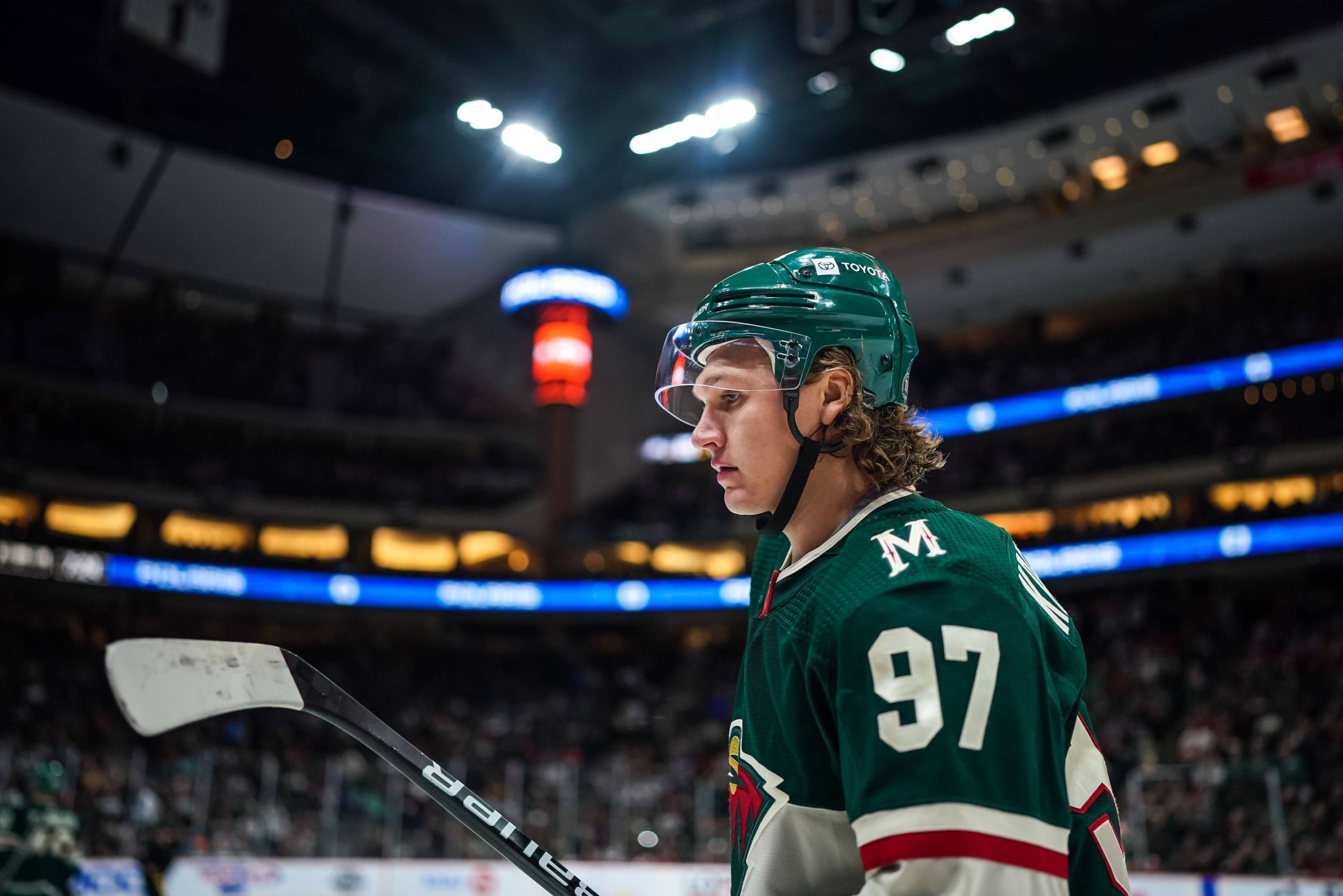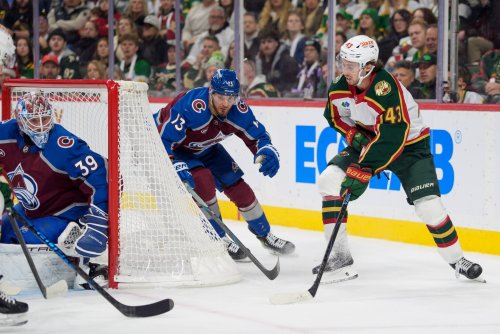
Kirill Kaprizov's 2021-22 season was so good that — four months after the regular season ended — we're still not done finding new ways to be amazed. Anyone who's seen him play can tell you he was one of the NHL's most impactful scorers. Heck, you can just tell that by going to an NHL leaderboard.
But we at 10K Rinks are working around the clock to find more ways to be impressed. The latest? Kaprizov was not only fifth in scoring with 108 points last season but also tied for fourth with 86 primary points. The only players to beat him? Connor McDavid (93), Johnny Gaudreau (92), and Leon Draisaitl (88).
What are primary points? That's goals, plus the primary (or first) assists. Assists are all graded equally — as one assist — but not all assists are equally impactful. Sometimes, the second assist is well-earned, crucial to making a goal happen. More often than not, though, the second assist is awarded to a player who happened to touch the puck before the scoring play.
This is where primary points become useful. By filtering out second assists, you eliminate some of that noise and hone in more on the plays that directly turned into goals. And if we look at Kaprizov's season through this lens, his year looks like one of the very best of the entire Analytics Era (2007-08 to today).
Don't get us wrong, Kaprizov's 108 points are tied with 2017-18 Connor McDavid for the 16th-most in that time. They look great now. But how many players do you think scored 86 or more primary points during that stretch?
The answer is ten. Alex Ovechkin and McDavid have done it twice. Then you have Gaudreau, Draisaitl, Sidney Crosby, Evgeni Malkin, Patrick Kane, Nikita Kucherov, and Auston Matthews. Kaprizov is the tenth. That's incredible, even if 86 is an admittedly arbitrary line to draw. Look at that list; each name could easily make the Hall of Fame.
Think about the great scorers who didn't make that list. Steven Stamkos will hit 500 goals at age 32 and surely make the Hall of Fame. He's not on here. Neither are the Sedin brothers. Some of today's best scorers, Nathan MacKinnon, Matthew Tkachuk, and Artemi Panarin, also aren't on the list.
Marveling at the list also leads you to ask: Did we already see Kaprizov's best season?
After all, aside from Ovechkin and McDavid, those players have just one 86-primary point season under their belt. Think about how good and for how long Crosby was, for example. He couldn't repeat the feat twice. Same with Malkin, or Kane, both of whom will (likely) never reach that peak again.
Maybe the better question is: Is it even possible for Kaprizov to do this again?
The good news is that Kaprizov is 25 and in his absolute prime. We're probably not going to see any sort of real decline from him until he gets past 30. And just because Crosby, Malkin, and Kane accomplished the feat once doesn't mean that Draisaitl (age 26), Matthews (24), or even Kucherov or Gaudreau (29) can't do it again.
Whether or not he can depends on two things. The first is, can he continue to be one of the very best shooters in the league? In his first two seasons, Kaprizov has played 2500 minutes, shot 10.5 times per hour, and is rocking an absurd 16.6% shooting percentage.
That's not just great shooting. It's all-time great stuff. Let's look at the highest shooting percentages from players who, in two-season stretches, played 2000-plus minutes and shot 10-plus times per hour.
2009-11 Crosby: 18.4%
2016-18 Patrik Laine: 18.0%
2020-22 Matthews: 17.7%
2013-15 Stamkos: 17.4%
2019-21 Matthews: 17.2%
2007-09 Thomas Vanek: 17.0%
2009-11 Stamkos: 16.9%
2018-20 David Pastrnak: 16.7%
2021-22 Kaprizov: 16.6%
It's just nearly impossible to shoot that much and that well for that long. If we look at these volume shooters throughout their careers, shooting percentage tops out at about 12%. Four players break the mold. Pastrnak is about 14% for his career, and Ovechkin is 13%.
Matthews shatters the mold of anyone with 150-plus games with 16.4% shooting over his career. Kaprizov is, again, at 16.4% for his career (131 games). If he doesn't continue his path as one of the best shooters of all time, the odds of repeating last season go down.
And it's not just him who has to shoot well. His teammates do, too. Otherwise, those primary assists will turn into shots on net.
Kaprizov has been elite at influencing shooting percentage for his teammates. That makes sense. His top-tier playmaking ability allows Mats Zuccarello and Ryan Hartman to get the puck in great shooting positions. Opponents are also drawn to Kaprizov, meaning they have more time and space to shoot.
Over his first two seasons with the Wild, the team has shot 11.4% with Kaprizov on the ice at 5-on-5. That ranks 10th in the NHL over the past two seasons among players with 1500-plus minutes. And being 10th in the NHL during that time makes his feat sound less exclusive than it is.
Before last season, when scoring rates boosted a bit across the NHL, few players saw this kind of great shooting from their teammates. At least, not over two seasons. Again, here's every forward from the Analytics Era who has had an on-ice shooting percentage of 11.4 or higher over a two-year stretch at 5-on-5:
2012-14 Ryan Getzlaf: 12.1%
2011-13 Martin St. Louis: 12.1%
2009-11 Daniel Sedin: 12.1%
2008-10 D. Sedin: 11.8
2019-21 Panarin: 11.7%
2019-21 Brock Boeser: 11.7%
2007-09 Ilya Kovalchuk: 11.7%
2011-13 Stamkos: 11.7%
2008-10 Henrik Sedin: 11.7%
2018-20 Evgeny Kuznetsov: 11.6%
2010-12 Stamkos: 11.6%
2009-11 H. Sedin: 11.6%
2007-09 Malkin: 11.6%
2016-18 Laine: 11.5%
2013-15 Getzlaf: 11.5%
2018-20 Brayden Point: 11.4%
2013-15 Corey Perry: 11.4%
Count them up, and that's 13 players who did that for 17 two-year stretches. Again, let's look at where things settle over the long run. Among players with 4000-plus career 5-on-5 minutes, only 10 players even have an on-ice shooting percentage over 10%. Stamkos and Mitch Marner (10.6% each) are where things top out at.
Again, Kaprizov is at 11.4% for his career. Therefore, unless he's by far and away the best playmaker of all time, he will not repeat that over a long, long period. Even if he's the best playmaker we've ever recorded, that percentage will drop. His numbers might, too.
Unless, of course, two things happen. The first thing Kaprizov can do is turn up the shot volume. Last year the Wild averaged 32.7 shots per hour at 5-on-5. That's good but still ranked just 94th in the NHL among forwards with 750-plus minutes.
Look at some of the most elite goal scorers in the league, and you'll see Pastrnak (4th with 40.9 shots per hour), McDavid (7th, 38.9), and Matthews (18th, 38.7). You don't have to rely so heavily on percentages when you're pushing the offense to an elite level. This might be a good argument to stack the top line rather than run things back with Zuccarello and Hartman.
And then there's the power play. The Wild had a 20.5% conversion rate last season, ranking 18th in the league. It feels like the ultra-talented Kaprizov left more points on the table because of it.
It might surprise you how good he was, individually, then. He was tied for 14th in the NHL with 29 points. As for primary points, he was tied for 20th with 21. That's good, no?
Sure is. But not elite, though, and Kaprizov certainly doesn't match his 5-on-5 dominance. Kaprizov shot 19.2% last year with the man advantage, which is great. But players like Josh Norris, Mika Zibanejad, Brandon Saad, Malkin, Matthews, and Draisaitl shot more often and accurately.
As for the on-ice stuff, Kaprizov neither got elite volume nor shooting luck from his teammates. The Wild shot 62.4 times per hour on the power play, 39th among 127 forwards with 150-plus minutes, but still far from the high-60s-to-70s rates where the elites sit.
And ugh, that shooting luck. The Wild converted 13.9% of shots with Kaprizov on the ice on the power play. Not only is that far from the Top-10 (19.3-20.5%), but the league average was 13.5%. How can Kaprizov be elite at driving shooting percentage at 5-on-5 but mediocre on the power play? It makes no sense.
Improving those numbers could get him the 8-10 points he needs to join the top power play producers. It also could make up for any losses in his 5-on-5 percentages as well.
It might not happen, though. We might have already seen Kaprizov's best. Even so, he should still be extremely great next season and for the foreseeable future.
There's really only one difference between him being merely great and repeating last year's feats. If he does the former, he's one of the best scorers in the league today. If he does the latter, we'll have to start discussing whether he's one of the best of our century.
Think you could write a story like this? Hockey Wilderness wants you to develop your voice, find an audience, and we'll pay you to do it. Just fill out this form.







Recommended Comments
There are no comments to display.
Join the conversation
You can post now and register later. If you have an account, sign in now to post with your account.
Note: Your post will require moderator approval before it will be visible.